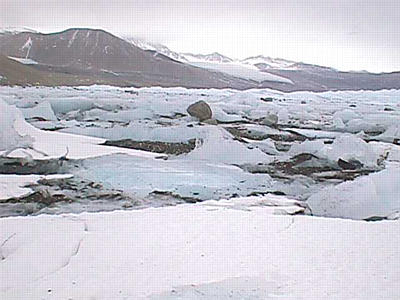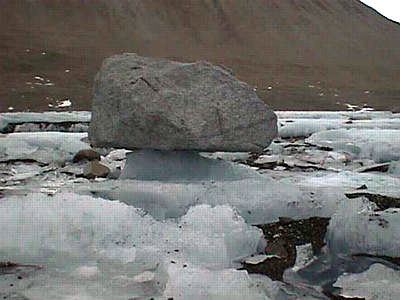11 November, 1998
Today our goal was to do some ice coring and algae gathering at Trough
Lake. It is a rather remote site, and the "powers that be" are thinking
about banning any visitation to the lake in the future [They really are
trying to preserve what is here so that human influence won't alter the
mini-ecosystems]...but for now we're allowed to go. My group has never
sampled there.
I woke at 6:00 am, showered (knowing that this would be my last shower
for about a week), and packed my bags to go back to camp (following our
trip to Trough Lake). I had breakfast and picked up the boxed lunches
for our day trip. I checked my e-mail and picked up the boxes of frozen
food that I had packed yesterday. I met Chris at the Crary Lab with the
boxes and my bags at 8:00 am. We were then picked up to go to the helo
pad. We would be meeting John, Ed, and Nina at Trough Lake. They were
flying from the Lake Bonney camp to the lake, and then we would all fly
back to camp together.
We flew off at 8:30 am and arrived at Trough Lake around 9:10am. We
landed on the opaque blue moat ice (remember this is the ice that
usually melts in the summer) and moved our equipment and survival bags
more into the middle of the lake. Every time we fly in a helicopter, we
are left with huge survival bags in case the helicopters cannot get back
to us on schedule. Today started out looking like one of those days.
The day was cloudy and the weather threatened to isolate us from any
access to home. It flurried a bit, but mostly it stayed cloudy and
chilly.
Trough Lake was amazing. It was like walking over a miniature world of
fantastic ice formations-- ice tables, holes, and caverns. There were
huge boulders in the middle of the lake that were held up by small ice
structures. They must have been frozen in and then the ice around it
gradually fell away. There were parts of the lake that had the clearest
dark blue ice in it. There were no bubbles all the way through this
part of the ice, so we could see for long distances down through the
ice...the ice was about 5 meters thick! This was the first lake that
Chris had seen that had this much sediment and algae just lying on top
of the lake. This was good because we could collect algal mat from the
top of the lake and study it quite easily.
While I collected algal mat and put it into Ziplock bags, Chris walked
over to the edge of the lake to collect more algae in the stream beds .
Ed, John, and Nina arrived around 11:45 am with the coring equipment and
drills.
The weather seemed to get a little colder as I collected the algae. We
guessed it was probably around 10 - 15 degrees F, much colder with the
wind when it picked up. We ate our boxed lunches before we began
coring.
I continued collecting algae, small flakes of Phormidium (a
cyanobacteria that grows in meltwater). I looked for the parts of the
snow that were "dirty", where sediment had fallen onto the snow and
caused it to melt a little. These were great places to find the algae,
because, as you know (since you just studied photosynthesis in great
detail), these algae need water and sunlight to photosynthesize. Some
of the mat was so thick and frozen in that I used a small Leatherman
(pocketknife) to chip away at it. John and Ed cored for about 45
minutes, stopping long enough for me to take pictures of them goofing
off (see picture below). Chris came back from the stream beds and took
over coring with Ed and Nina while John went for a walk to the stream
beds.
After collecting a bag of algae (yes, it doesn't seem like much, but it
took a long time to collect that amount!), I collected ice from the ice
table (the top ice on the lake) for meltwater for our experiments back
at the Lake Bonney camp. Nina and I finished this task while the guys
decided to hike over to the glacier that loomed over the head of the
lake. At 4:45 pm the helicopter arrived to take us back to camp. They
first landed near Nina and me and picked up our gear, and then we went
to pick up the guys who were at the edge of the glacier. [Wow, these
helicopters land very close to us when we're on the ice...which makes it
easier to load the helicopter...but we have to hold everything down when
they land and take off because, otherwise, everything would go blowing
away. There's quite a bit of windpower there!]
On the way back to camp, we refueled at a place called Marble Point.
This is one of the locations that helicopters refuel when they are a
long distance from McMurdo. It really is a small place with just enough
room for 8 people to stay should their flights get delayed back to
McMurdo or camp because of weather. The pilots mentioned that we might
have to stay there overnight because of the weather, but we loaded up
again and headed out for camp. Whew!
We got back to camp and found that "freshies" had arrived. This is a
big thing here in camp, I guess. It's when McMurdo is able to send out
fresh food, rather than canned, frozen, and dried food...things like
onions, potatoes, carrots, celery, eggplant, yogurt, apples, oranges,
and cabbage. It's like Christmas!
Ed made hamburgers for the group (a total of 10 people still because the
LTER...or Limno...team are still here).
I went to bed at 10:30 pm and slept very well. I sleep much better out
in my tent than I do at McMurdo...maybe it's because living conditions
at McMurdo are more like a dorm, and the noise can get excessive at
times. Of course, being out all day in the cold helps me sleep, too.

The bumpy surface of Trough Lake. Crampons are a must on this kind of ice!

A flake of the algae found on Trough Lake. The algal flakes were lying all along the surface of the ice in areas where there would have been meltwater at one time.

Look at how this rock is balanced on an ice structure. Doesn't it look like it could fall off at any time?

This is one of the many ice tables we saw on this lake...incredible formations...a whole miniature world under the top layer of ice.

John (the victim) and Ed (ice corer) goofing off with the ice coring drill. Do not try this at home!
Contact the TEA in the field at
.
If you cannot connect through your browser, copy the
TEA's e-mail address in the "To:" line of
your favorite e-mail package.
|
